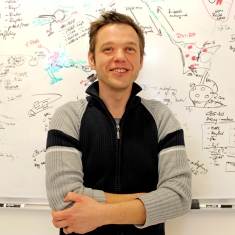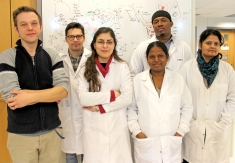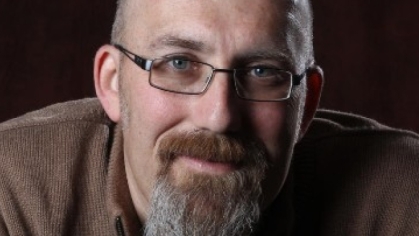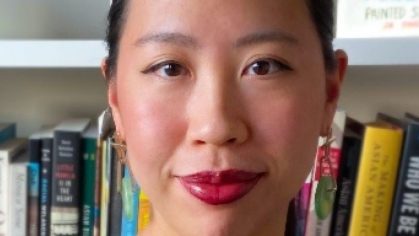Radek Dobrowolski: On the Front Lines of Research Into Brain Injuries
The self-eating of neurons in the brain. The build-up of plaque. The first sounds like a scene from TV’s “The Walking Dead,” the other sounds like a toothpaste ad. But in reality, both are processes that play major roles in determining whether individuals develop debilitating brain diseases, and a Rutgers University-Newark (RU-N) biologist, Dr. Radek Dobrowolski, is on the front lines in researching each phenomenon.

Dobrowolski, assistant professor in the Department of Biological Sciences/Faculty of Arts and Sciences, is the principal investigator of “Brain Injury Induced Alzheimer’s-Like Disease,” a multi-school research collaboration aimed at developing new therapeutic compounds to prevent destructive processes within the brain triggered by traumatic brain injury -- processes linked to Alzheimer’s and Alzheimer’s-like diseases. To further the research efforts of Dobrowolski and his team, RU-N awarded Dobrowolski and his collaborators an $80,000 Initiative for Multidisciplinary Research Teams (IMRT) Awards in May 2015.
Through the IMRT Awards, which range from $26,720 to $80,000, RU-N seeks to invest in collaborative academic and research programs that promote interdisciplinary research and collaboration among RU-N faculty, departments, schools, and centers as well as other anchor institutions, and help faculty to compete more effectively for external funding. Another important goal is to encourage and support meaningful involvement of graduate students and/or postdoctoral fellows in research endeavors. “Brain Injury Induced Alzheimer’s-Like Disease” fits perfectly into the IMRT goals, teaming Dobrowolski with a diverse group of collaborators: Dr. Kevin Pang, Veterans Administration in East Orange; Dr. Bryan J. Pfister, New Jersey Institute of Technology; Dr. Steven W. Levison, New Jersey Medical School; Dr. Thomas Biederer, Tufts University; and RU-N doctoral biology student Chaitali M. Saqcena.
The research also aligns with two other significant goals of the IMRT Awards: the potential for sustained external funding, and emphasis on developing a research program, rather than a limited-term project. Both are possible, since the team’s work has great relevance for two institutions where head injuries are a growing concern: The U.S. Department of Defense, in light of the huge number of head injuries suffered by U.S. troops in Afghanistan and Iraq, and the sport of football, where the hot topic is the possible long-term impacts of repeated concussions. In fact, the research team’s work has already attracted the attention of the U.S. Department of Defense, which invited it to submit a funding proposal. “Obviously the DoD finds the project very promising,” Dobrowolski remarks.
Dobrowolski explains that Alzheimer’s is linked to buildup of plaque on a protein in brain neurons called tau, and the plaque disrupts the neurons’ communication processes. This in turn leads to memory loss and inability to perform simple tasks. Previous research in the field has shown that traumatic brain injury leads to creation of tau, and hence, the buildup of plaque.

Dobrowolski and his team are trying to find out why the injuries increase tau protein; the answer could then pave the way to interrupting the process, thus preventing the buildup of tau and the accompanying plaque.
One way they are investigating this is by creating human neural cells in a lab, “injuring” them and then studying how and why the injuries disrupt the neural cells’ communications processes. Here’s how they do it: The scientists “reprogram” skin cells to become a type of human stem cell called “induced Pluripotent Stem cells” by treating them with chemicals to alter their development into neurons. The neurons then develop communications networks. Once these develop, the researchers use specialized equipment to hit the neurons with puffs of air, which stretches the neurons and “injures” them. The researchers then study how the neural cells respond.
Based on what they have learned so far, the researchers are experimenting with the use of chemical compounds called peptides as a way to re-regulate the communications processes that are disrupted by injury, according to Dobrowolski. He and his team are seeking to develop peptides which could then be applied to the damaged cells to re-regulate how the cells communicate.
Another focus of the research involves the synapses, the messaging pathways that allow neurons to communicate with each other. With Tufts collaborator Thomas Biederer, the team is investigating “synaptic collapse.” This breakdown of the messaging pathway is one of the first signs of Alzheimer’s. The collapse is linked to a process called “self-eating.” When cells are damaged – in the brain or elsewhere – self-eating allows healthy cells to break down the damaged parts and eliminate them. This is considered a normal process, yet when damaged neurons excessively induce the self-eating process, communication between neurons collapses, leading to memory loss and the inability to do everyday tasks that is symptomatic of Alzheimer’s. The researchers are seeking to better understand the relationship between the accumulation of Tau, self-eating in neural cells and synaptic collapse. The researchers hypothesize that a re-regulation of the neuronal self-eating process will stop the “synaptic collapse” and restore inter-neuronal communication, thereby avoiding injury-induced memory loss.
Prior to coming to RU-N Dobrowolski was a postdoctoral research associate at Howard Hughes Medical Institute at the University of California, Los Angeles. Dobrowolski received his diploma in biology, in molecular genetics and his Ph.D. in cell and molecular biology, both from the University of Bonn, Germany. During his studies there he worked as a scientific assistant and a scientific co-worker in the university’s Institute of Genetics.
A member of the NY Academy of Sciences and the Gerontological Society of America, Dobrowolski’s research has also been supported through grants from the American Federation for Aging Research (AFAR), the International Alzheimer's Association, the Brain Health Institute of NJ, and NJC Brain Injury Research. He also was recognized with the 2015 Margaret M. Cahn Research Award for promising contributions to the study of Alzheimer's disease.
Large Image by Radek Dobrowolski shows human neurons with Alzheimer's disease after reprogramming from a skin biopsy.
INSET PHOTOS:
Top: Radek Dobrowolski in front of the white board that he and his team use to discuss their working hypotheses and experimental results. Bottom: Dobrowolski and his team. (L-R): Henri Antikainen, Khoosheh Khayati, Israel Nngh, Chaitali Saqcena, and Sweta Singh. Photos by Nora Luongo.


